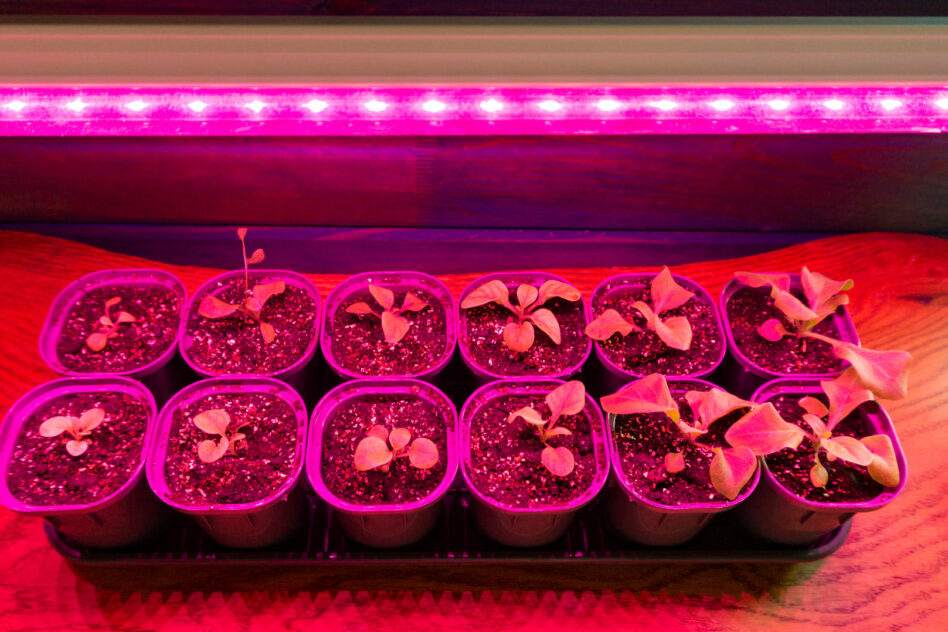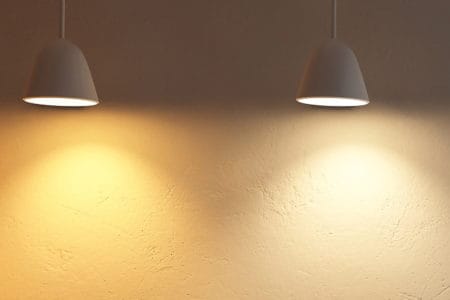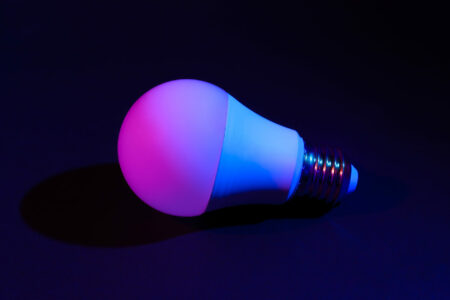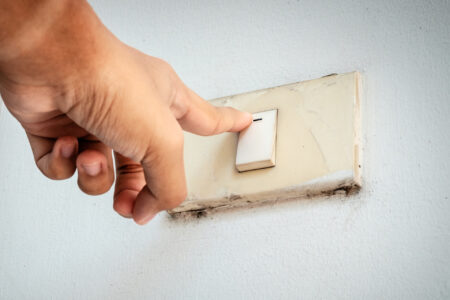Caring for houseplants is a challenging task. Proper lighting is a crucial factor to take into account. But it’s hard to provide just the right lighting for your plant to thrive. When you begin looking for alternatives, one of the most common options is LED strip lights. But can you use LED strip lights to grow your plants? Let’s find out below.
Can You Use LED Strip Lights to Grow Plants?
Yes, you can. Thankfully, LED strip lights are suitable enough to provide the proper requirements for houseplants to grow. There are some caveats, however. Still, they can provide the light that a plant needs for photosynthesis—reaching its full potential.
Chlorophyll needs to absorb light to give the plant its green and blooming appearance; and LED bulbs provide just that. Chlorophyll absorbs both red and blue light waves and turns them into green ones. And LEDs? They provide both waves.
How Can I Use LED Strip Lights to Grow Plants?
Firstly, you must understand that not all LED lights can help a plant grow. It’s specifically LED strip lights. It’s worth mentioning that they only assist in plant development.
Yet, LED strip lights won’t be bright enough to give seedlings the light they need to grow. That’s why you’ll need larger, brighter bulbs.
To better understand the caveats of using LED strip lights to grow plants and how to optimize them, let’s look into the main aspects.
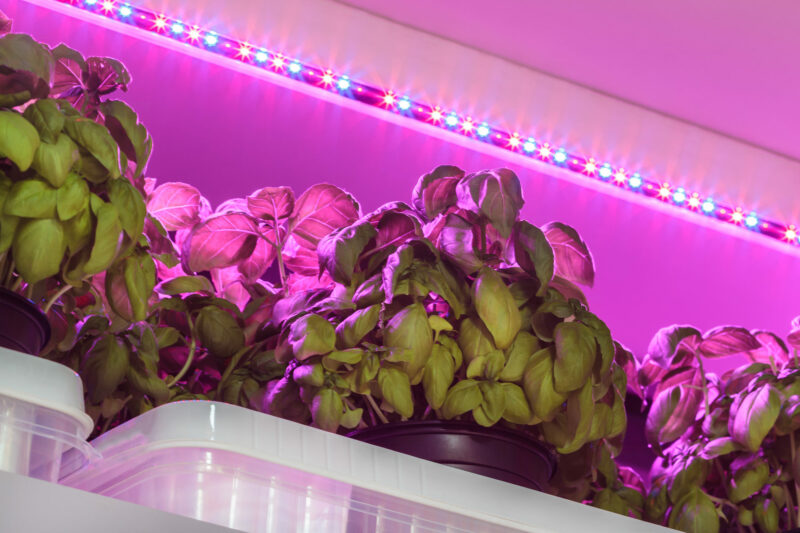
Amount and Intensity of Light
The lights you provide indoors have to match what the plant would typically need—and find—in nature.
You’ll need bright light to help seedlings and young plants prosper. As your plant matures, it can handle a little less light, and can even do with dimmer lighting.
Generally, 2,000 lumens per square foot of lighting would suit a plant’s growing cycle. Yet, standard LED strips can provide only 450 lumens per foot.
The 5050 LED strips or above would be a good option for plant growth. They come with three LED chips in one, providing higher brightness than standard LED strips.
If you’re going to use standard ones, however, you should be using them only as supplements to other lighting forms.
The Light Spectrum
Plants would get the full-color spectrum from the sun’s rays in their natural environment. However, when indoors, you’ll have to ensure that yourself.
This means you need to give the plant blue light to help it grow and red light to stimulate flower growth.
Failing to do so means that your plant might not produce any flowers. Even worse, your plant might not be able to grow at all.
Not to mention, during the seedling’s early growth stages, your plant will need an intense amount of blue light.
To imitate daylight, your plants should be getting 6,500K during the seedling stage. Once they’re in the stage of producing buds, flowers, and fruits, they can suffice with 3,000K.
While any LED strips you get would be able to provide the blue and red light wavelengths, you have to check whether they can provide the right levels for your plant.
A tunable bulb might be an even better option as you can adjust the wavelengths. You can set them to be high or low to suit your plant’s needs.
Alternatively, you can opt for RGB lights and switch between red and blue. A third choice would be multiple strip lights—some blue and some red.
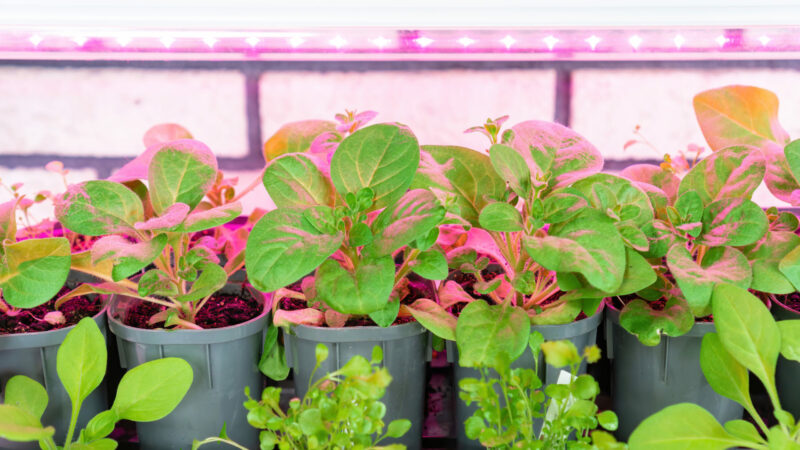
Benefits of LED Strip Lights for Plant Growth
Compared to other sources of plant growth light, what distinguishes LED strips?
Minimal Heat Production
One of the most important benefits of LED bulbs is that they emit the least amount of heat of all light sources.
This fact is important for plant growth. It means that your plants won’t dry out or become dehydrated because of the heat the light produces.
Not only that, but this is a general advantage that makes LED lights energy-efficient. Since they emit so little heat, they don’t waste energy.
Ideally, bulbs should produce only light. Their heat is considered as lost energy since that dissipated heat would have been light energy.
So, LED lights keep your plant safe from dehydration and dryness as well as save you lots of energy while doing so.
Lifespan
Compared to any other light source, LEDs have the longest life —up to five or six times longer than fluorescent options.
The shelf life starts anywhere from 15 thousand hours and goes all the way to 50 thousand.
This makes them super convenient, as you wouldn’t need to replace them often.
What’s the Difference Between Grow Lights and LED Lights?
You’ll find that regular LED lights are ubiquitous. However, LED growth lights come with the edge of having red and blue lights. This feature encourages plant development, growth, budding, flowering, and producing fruits.
Diversity
Grow lights exist in many colors. You can choose the ones that suit you according to your desired coverage, the nature of your plants, and the availability of growing spaces.
Colors
LED lights don’t have the full spectrum, while grow lights do. They focus on providing the red and blue wavelengths to stimulate plant growth and full development.
Purpose
Because grow lights are meant for plants, they come with a full spectrum, multiple colors, and less wattage usage.
Price
LED lights are ubiquitous, which makes them affordable. Contrarily, grow lights are on the expensive end of the spectrum. Their price increases depending on their intensity, lifespan, power consumption, sizes, and coverage area.
Energy Consumption
Grow lights are a lot more inefficient in terms of wattage consumption, especially when you compare them to regular LED lights.
Eye Safety
LED lights come with eye protection, given that they’re meant for everyday use. However, grow lights might damage your eyes. That’s why you should keep a safe distance around grow lights.
Supporting Plant Growth
Regular LED lights won’t get you anywhere when it comes to your plant blooming, budding, flowering, or yielding. On the other hand, grow lights will provide the right wavelengths and color spectrums for your plant to fully prosper.
FAQs
How Important Are Lumens When Choosing LED Strip Lights for Plant Growth?
While lumens give you a direction on a LED strip’s suitability, they’re not enough. That’s mainly because the lumen measurement is based on yellow light alone.
However, a plant will require the full spectrum of color—including blue and red—, which is more important than lumen measurement.
Can I Use LED Lights as Grow Lights?
If you’re going to use LEDs, they ought to be strip ones for growth purposes. Keep in mind that regular ones won’t do the job.
LED strips have to be used with specific aspects in mind. Otherwise, they won’t be enough and you’ll need a source of brighter light.
Can I Make DIY Grow Lights Using Strip Lights?
Yes, you definitely can. You start by cutting the strip lights to match your growing space’s width. Then, peel the paper off and attach the strips to the aluminum bars.
The aluminum dissipates the heat to protect your plant from excessive heat. After that, add solderless connectors to the strip lights. You may want to tie the wires with nylon ties to enhance stability too.
Finally, insulate the panels by applying silicone blobs on the connections.
